Modulation of TASK-like background potassium channels in rat arterial chemoreceptor cells by intracellular ATP and other nucleotides
- PMID: 17615104
- PMCID: PMC2156202
- DOI: 10.1113/jphysiol.2007.135657
Modulation of TASK-like background potassium channels in rat arterial chemoreceptor cells by intracellular ATP and other nucleotides
Abstract
The carotid body's physiological role is to sense arterial oxygen, CO(2) and pH. It is however, also powerfully excited by inhibitors of oxidative phosphorylation. This latter observation is the cornerstone of the mitochondrial hypothesis which proposes that oxygen is sensed through changes in energy metabolism. All of these stimuli act in a similar manner, i.e. by inhibiting a background TASK-like potassium channel (K(B)) they induce membrane depolarization and thus neurosecretion. In this study we have evaluated the role of ATP in modulating K(B) channels. We find that K(B) channels are strongly activated by MgATP (but not ATP(4)(-)) within the physiological range (K(1/2) = 2.3 mm). This effect was mimicked by other Mg-nucleotides including GTP, UTP, AMP-PCP and ATP-gamma-S, but not by PP(i) or AMP, suggesting that channel activity is regulated by a Mg-nucleotide sensor. Channel activation by MgATP was not antagonized by either 1 mm AMP or 500 microm ADP. Thus MgATP is probably the principal nucleotide regulating channel activity in the intact cell. We therefore investigated the effects of metabolic inhibition upon both [Mg(2+)](i), as an index of MgATP depletion, and channel activity in cell-attached patches. The extent of increase in [Mg(2+)](i) (and thus MgATP depletion) in response to inhibition of oxidative phosphorylation were consistent with a decline in [MgATP](i) playing a prominent role in mediating inhibition of K(B) channel activity, and the response of arterial chemoreceptors to metabolic compromise.
Figures

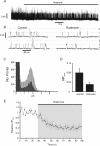
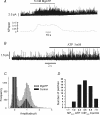
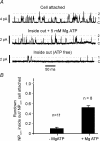
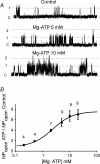
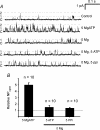


References
-
- Abraham MR, Selivanov VA, Hodgson DM, Pucar D, Zingman LV, Wieringa B, Dzeja PP, Alekseev AE, Terzic A. Coupling of cell energetics with membrane metabolic sensing. Integrative signaling through creatine kinase phosphotransfer disrupted by M-CK gene knock-out. J Biol Chem. 2002;277:24427–24434. - PubMed
-
- Anichkov S, Belen'kii M. Pharmacology of the Carotid Body Chemoreceptors. Oxford: Pergamon Press; 1963.
-
- Ashcroft FM. Adenosine 5′-triphosphate-sensitive potassium channels. Annu Rev Neurosci. 1988;11:97–118. - PubMed
-
- Bayliss DA, Talley EM, Sirois JE, Lei Q. TASK-1 is a highly modulated pH-sensitive ‘leak’ K+ channel expressed in brainstem respiratory neurons. Respir Physiol. 2001;129:159–174. - PubMed
Publication types
MeSH terms
Substances
LinkOut - more resources
Full Text Sources
Medical
Miscellaneous

